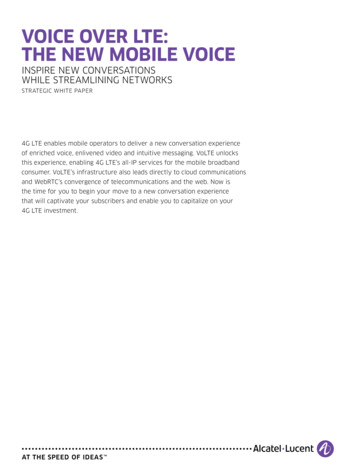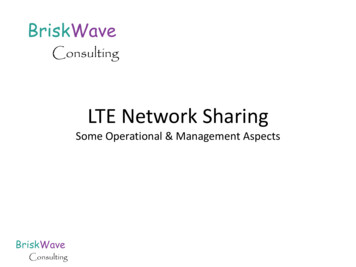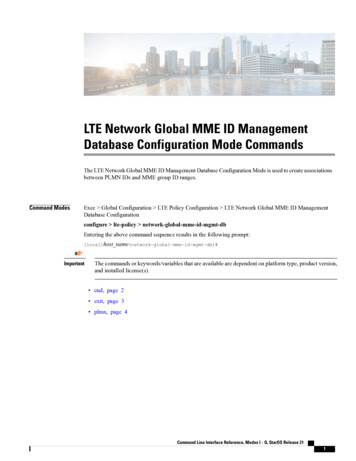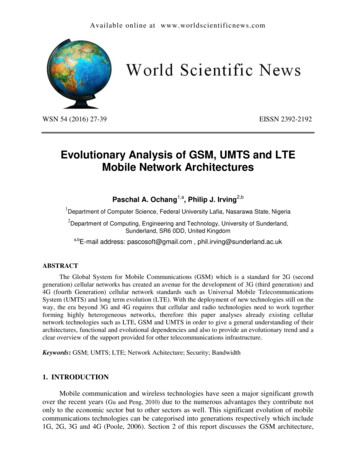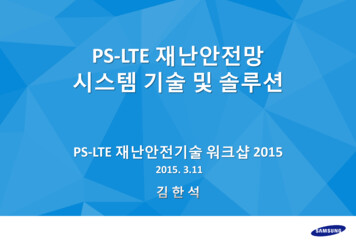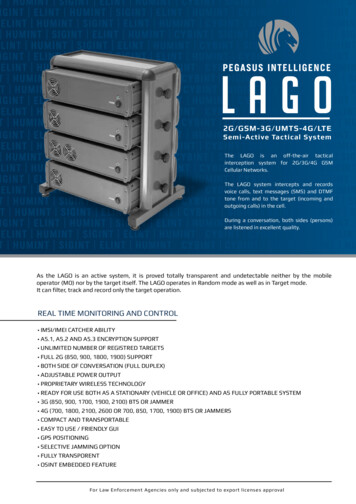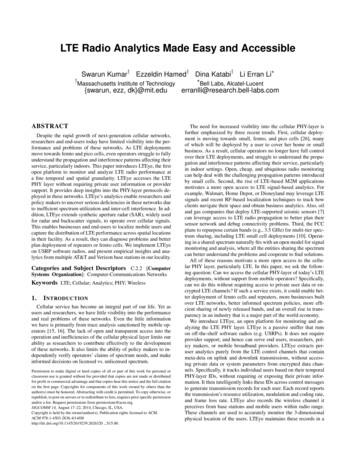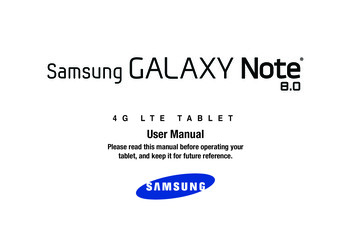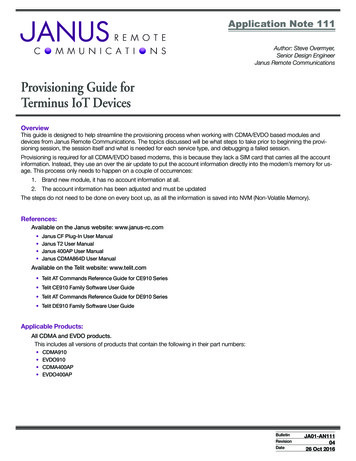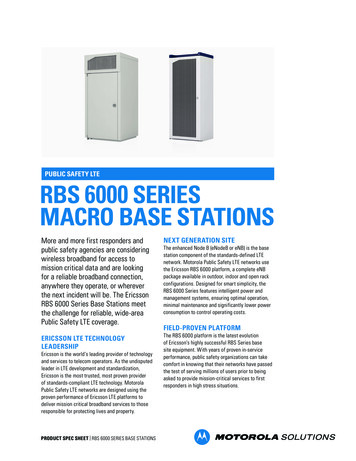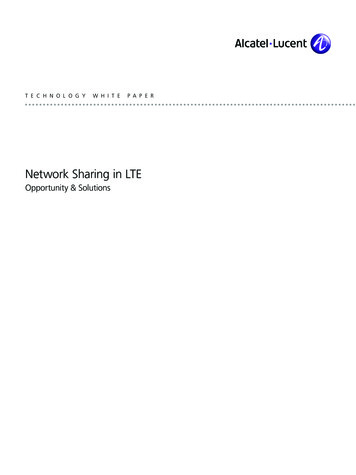
Transcription
T E C H N O L O G YW H I T EP A P E RNetwork Sharing in LTEOpportunity & Solutions
Table of contents11. Market overview2 1.1 Opportunity for network sharing in LTE3 1.2 Customer cases4 1.3 Challenges for eUTRAN sharing42. Standards perspective4 2.1 Roaming and eUTRAN sharing in 3GPP83. Alcatel-Lucent solution for eutran sharing and key differentiators14 3.2 End to end network architecture for eUTRAN sharing164. Acronyms
1. Market overviewMobile Service Providers (MSP) are facing new challenges. On one hand, the number of datasubscribers as well as the data usage per subscriber is exploding. On the other hand the generatedrevenue does not increase the same way. These challenges are depicted in Figure 1.Data traffic explosion is explained by both a change in the way we communicate and a rapid changein wireless devices, enabling anytime, anywhere multimedia communications. Millennials, looselydefined as 11 to 30 years-olds, are redefining the way consumers interact in both a social and businesssetting. They intuitively and rapidly adopt new services and devices. They not only text, but theyalso download music and videos, play games, and use social networking sites such as Facebook andMySpace to stay socially connected. With their high Internet content consumption, this group morethan doubles the average subscriber’s mobile data usage. Furthermore, as Millennials enter adulthoodand the workforce, they are also changing the way the enterprise communicates.Rapid changes in wireless devices, enabling anytime, anywhere, multimedia communications, havealso played a major role in the data explosion. Some wireless devices are being integrated with cameras,video recorders, iPods, and media players. Others, like e-Readers, are not being integrated at all, butrather customized to deliver a high quality of experience for only one particular application. All thesedevices, however, are simplifying multimedia communications, enabling it to flourish.Revenue generated by the data traffic explosion will not increase the same way because the subscribersare used to benefit from broadband access at low price.This market evolution poses new challenges to MSP. They need to deploy wireless networks ableto sustain more capacity while reducing the total cost of ownership and finding new businessmodels generating new sources of revenue. In this context, network sharing is a way to reduceCAPEX and OPEX.Figure 1. Mobile Service Providers new challenges.Non user-paid revenuesTCO and carbon footprintTrafficUser-paid revenuesBroadbandnetworkNewbusinessmodelUnlimited wireless triple playNew value chainVoice-centricPay per minuteEnrichedserviceand QoEVoice and multimediaPay per useWalled gardenEfficientnetwork andoperations2000-20052005-20102010-2020Network Sharing in LTE Technology White Paper1
1.1 Opportunity for network sharing in LTENetwork sharing is not new in the wireless business. Operators throughout the world already sharetransmission towers and sites. In France, Orange shares 40% of sites with other operators in rural areas.Telefonica and Vodafone have announced Europe’s first multi-market network sharing deal. Thepartners will share sites and equipments, where appropriate in the UK, Ireland, Germany and Spain.However most of network sharing agreements today are limited to passive sharing in which operatorsshare the sites and civil engineering elements. Active network sharing where operators share basestations, antennas or even radio network controller is not widely deployed in 2G and 3G.Will this change with LTE?Will active sharing exist with LTE?Several facts can enlighten the reflection: Cost saving is still an incentive even if estimates vary on what operators can save by sharinginfrastructure. This can be a catalyst especially in the global economic downturn. Mobile network operators have learnt from sharing experiences with 3G and attitudes towardssharing are obviously changing. LTE deployments will require major investments. And even if LTE will enable high-speed ser v ices that promise a flood of traffic, the revenue they generate will not likely increase the sameway, especially because the subscribers are used to benefit from broadband access at a low price. Sharing mechanisms have been built into the LTE standard from the beginning. LTE is designed with a modern IP-based architecture in mind and IP-based technology is a moreflexible platform than legacy technologies. It also provides standard mechanisms to interlinkwith other IP-based systems. Some countries are pushing to reduce the digital divide (e.g. Digital Britain initiative in the UKrequesting at least a network speed of 2 Mbits/s in every home). This kind of initiative combined with the availability of the 800 MHz band and the fact that it is not economically viablethat each operator deploys its own network in rural areas could be an important incentive todeploy shared LTE networks in rural areas. This could lead to the emergence of pure LTE wholesale players deploying the shared eUTRAN in rural areas, each CN operator deploying its owneUTRAN in dense urban areas where capacity demand justifies a dedicated eUTRAN per CNoperator (refer to 1.2.1). In certain cases sites constraints can lead to a eUTRAN sharing solution (e.g. difficulties toinstall new antennas).However, regulators in most countries embrace passive sharing as a mean to avoid network duplication, reduce upfront investment costs and minimize the impact on the environment, while creating incentives to roll out services in underserved areas. On the other side active sharing remains amore contested issue. Their argument is that it could lead to anti-competitive conduct in prices andservices. For example national roaming in France is only allowed in “white zone1” areas. On thecontrary Nordic countries are more open to network sharing.Whether LTE will drive infrastructure sharing to a new height remains to be seen. However asmentioned above there are a lot of factors that tend to think that there are opportunities for tighternetwork sharing in LTE. This is also reflected by feedback from customers.12A « white zone » is an area with a low density of population where it is not economically viable that each operator deploys its own network.Network Sharing in LTE Technology White Paper
1.2 Customer casesThis section aims at illustrating use cases for eUTRAN sharing already encountered.1.2.1 LTE capacity wholesalerIn one European country a company plans to become a pure LTE capacity wholesaler. This company plans to deploy a broadband network using the LTE technology in rural areas and wholesalesnetwork capacity to mobile and potentially fixed network operators. Mobile network operators willdeploy their own LTE network in dense urban areas where capacity demand justifies that operatorsinvest in their own LTE network. Those mobile network operators will also be connected to theshared eUTRAN managed by the wholesaler to provide mobile broadband services in rural areas.The market situation An initiative of the government sets out the importance of the Digital Economy to the nation’seconomic future and how it will drive future industrial capability and competitiveness. In particular the government sets a target of Universal Service Broadband Commitment at 2Mbpsby 2012. Significant demand in rural areas for good quality broadband. Auction for both the 800 MHz and the 2.6 GHz bands is planned in Q2-2010. The 800 MHzband, due to its propagation characteristics, will be used for rural deployments. and the company assets (i.e. radio sites all over the country) justify the pure wholesale model.It should be noted that the wholesaler does not plan to own its own spectrum but foresees a businessmodel in which the wholesaler rents the spectrum from spectrum owners and in return sells LTEwholesale capacity.1.2.2 LTE network sharing Joint Venture (JV)A joint venture created by two operators is today managing a shared 3G radio access networkbetween those two operators. Based on this experience, the two operators have decided to alsoshare their 2G and LTE access networks. The main drivers are harmonization of all their radioaccess networks and cost reduction.Two main technical points were debated with these two operators: Which strategy to use for PLMN ID in the shared eUTRAN?Two alternatives were possible: PLMN ID of each operator is broadcasted or a common PLMNID is broadcasted. As in LTE the UE shall support a list of PLMN IDs and a network selectionprocess (refer to 2.1.2) Alcatel-Lucent promoted the broadcast of each operator PLMN ID onthe air interface. This is fully compliant with the 3GPP eUTRAN sharing approach. To benoted that in 3G it is not mandatory for a UE to support a list of PLMN IDs. Hence in caseof 3G UTRAN sharing a common PLMN ID is defined. This common PLMN ID is used by3G UE not supporting a list of PLMN IDs. How traffic separation between operators is done in the shared eUTRAN?Traffic separation is done using VLANs (refer to 3.1.3). This allows to easily fulfilling one of therequirements of those two operators to be able to route each operator’s traffic to their respectivebackhaul network as soon as possible.Network Sharing in LTE Technology White Paper3
1.3 Challenges for eUTRAN sharingAs explained above, network sharing is a way to reduce CAPEX and OPEX. However a successfulnetwork sharing deployment shall take into account the following challenges: Quality and service differentiation An homogeneous QoS shall provided over the shared and the dedicated eUTRAN.Quality of Experience shall be the same for the subscribers. Differentiation between partners will be at services and applications level. Regulation Negotiation with the regulator to adapt license conditions could be needed. Commercial and legal aspects If applicable, establishing a joint venture between sharing partners will be needed. Agreement on a service level agreement, penalties, scope and duration shall be defined, Agreement on the expenditure split and model shall be defined.2. Standards perspectiveTwo technical solutions are presented in this document, namely National Roaming and eUTRANsharing. They both allow the sharing of the LTE network even if they differ on the business andtechnical relationships between involved partners.In the national roaming approach, as its name indicates, relationships between partners follow thewell known roaming agreements model. Operators are not required to share any common networkelements. Traffic from one carrier is carried over the network of another.In eUTRAN sharing, a tighter business and technical relationship between partners is needed asoperators share the active electronic network elements like base stations. A shared eUTRAN isconnected to each operator core network.2.1 Roaming and eUTRAN sharing in 3GPP3GPP standards applicable to roaming and eUTRAN sharing are listed in the table below:StandardVersionSpecification DescriptionTS 23.401V8.6.0General Packet Radio Service (GPRS) enhancements for Evolved Universal TerrestrialRadio Access Network (E-UTRAN) access (Release 8)TR 22.951V8.0.0Service aspects and requirements for network sharing (Release 8)TR 23.251V8.1.0Network Sharing; Architecture and functional description (Release 8)2.1.1 Roaming in 3GPP3GPP has defined two approaches for roaming in LTE, namely the home routed traffic and the localbreakout approaches. They are depicted in Figure 2 and Figure 3 respectively. These two approachesdiffer on the location of the PGW. In the home routed traffic the PGW is located in the homenetwork. Thus subscriber’s traffic is routed up to the home network. In the local breakout the PGWis located in the visited network. Subscriber’s traffic is routed locally at the visited network level. Inboth approaches the HSS is located in the home network.National roaming can be seen as an alternative to eUTRAN sharing. However, the main disadvantageof national roaming is that the PLMN ID of the visited network is broadcasted on the air interface.So this is not transparent for the subscribers in roaming situation. Most of the time national roamingis used as a way to support geographical split agreements between operators. Each operator deployingits own network and using its own spectrum. So in case of national licenses, the whole availablespectrum is not used. For those reasons, national roaming is more appropriate either in some markets4Network Sharing in LTE Technology White Paper
where licenses are allocated on a regional basis or for early LTE deployments between operatorswishing to provide a broad LTE coverage from the beginning but who do not want to establishlong-term relationships.National roaming is not described in details in this document.Figure 2. Roaming in LTE with home routed traffic.Visited networkHome networkRoamingagreementsOperator AOperator BHSSMMESGWPGWIInterneteUTRANOperator B’ subscribersFigure 3. Roaming in LTE with local breakoutVisited networkHome networkRoamingagreementsOperator AHSSMMESGWPGWOperator BInterneteUTRANOperator B’ subscribersNetwork Sharing in LTE Technology White Paper5
2.1.2 eUTRAN sharing in 3GPPIn the eUTRAN sharing approach the LTE eUTRAN is common to several mobile network operatorsand shared between them. Several CN are connected to the common shared eUTRAN. This is depictedin Figure 4. The left side of Figure 4 shows the non sharing approach where both the eUTRAN andthe EPC belong to a single operator. In this case the eUTRAN is connected to a single EPC (i.e. operatorA’s EPC). The right side of Figure 4 shows the eUTRAN sharing approach where the eUTRAN iscommon to several mobile network operators and connected to several EPC, one EPC per mobilenetwork operator. As shown on the figure, each mobile network operator can have its own eUTRAN(i.e. a dedicated eUTRAN) in addition to the common shared eUTRAN shared with other mobilenetwork operators. For instance, each mobile
Which strategy to use for PLMN ID in the shared eUTRAN? Two alternatives were possible: PLMN ID of each operator is broadcasted or a common PLMN ID is broadcasted. As in LTE the UE shall support a list of PLMN IDs and a network selection process (refer to 2.1.2) Alcatel-Lucent promoted the broadcast of each operator PLMN ID on the air interface. This is fully compliant with the 3GPP eUTRAN sharing
